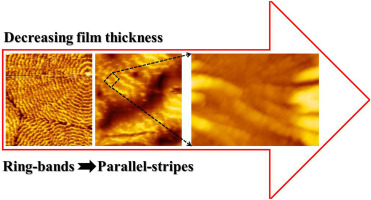Polymer ( IF 4.6 ) Pub Date : 2017-09-11 , DOI: 10.1016/j.polymer.2017.09.015 Yu Zhu , Qiucheng Yang , Fei Li , Huijuan Yue , Jichun You , Yongjin Li

|
Poly(l-lactic acid)/poly(oxymethylene) bulky blend is a typical system exhibiting ring-banded spherulites. In this work, however, the parallel ridges and valleys were fabricated for the first time in the blend film by the precise control of film thickness. They are named as “parallel-stripe structures” to distinguish from general “ring-banded structures”. Our results indicate that the cracks on thinner films prevent the development of ridge/valley rings along the film, accounting for the formation of these parallel structures. Consequently, they can reduce the influence of the fractal and resultant branching lamellae which makes the investigation of ring-banded structures more complicated. On the other hand, a novel in-situ etching method has been established to investigate the composition distribution of PLLA and POM in film thickness direction. As a result, the tri-layer structures including top-PLLA layer, blend layer and bottom-POM layer were reconstructed and validated by melting contact angles. Based on the atomic force microscope and transmission electron microscope results, it is concluded that the twisting model dominates the formation of parallel banded structures in PLLA/POM blend film. Furthermore, the crystallization temperature and composition dependence of lamellae twisting has been investigated in detail. On one hand, the increase of crystallization temperature leads to the well-developed POM crystal lamellae, which is the reason for the slower twisting. On the other hand, blend films with higher PLLA weight fraction produce bigger period and smaller radius during POM lamellae twisting because of the depression of the top PLLA wetting layer.
中文翻译:

PLLA / POM混合膜中的平行条纹结构
聚(l-乳酸)/聚(甲醛)大体积共混物是显示出环带状球晶的典型体系。然而,在这项工作中,通过精确控制膜厚,首次在混合膜中制造了平行的凸脊和凹谷。它们被称为“平行条纹结构”,以区别于一般的“环带结构”。我们的结果表明,较薄的薄膜上的裂纹阻止了沿薄膜的脊/谷环的发展,这说明了这些平行结构的形成。因此,它们可以减少分形和由此产生的分支薄片的影响,这使得对环状结构的研究更加复杂。另一方面,已经建立了新颖的原位蚀刻方法以研究膜厚度方向上PLLA和POM的组成分布。结果,重建了包括顶层PLLA层,共混层和底层POM层的三层结构,并通过熔化接触角进行了验证。根据原子力显微镜和透射电子显微镜的结果,可以得出结论,扭曲模型主导了PLLA / POM共混膜中平行带状结构的形成。此外,已经详细研究了片状扭曲的结晶温度和成分依赖性。一方面,结晶温度的升高会导致POM晶体片层发达,这是扭曲较慢的原因。另一方面,具有较高PLLA重量分数的共混薄膜会由于顶部PLLA润湿层的凹陷而在POM片材扭曲过程中产生较大的周期和较小的半径。重构了顶层PLLA层,混合层和底层POM层三层结构,并通过熔化接触角进行了验证。根据原子力显微镜和透射电子显微镜的结果,可以得出结论,扭曲模型主导了PLLA / POM共混膜中平行带状结构的形成。此外,已经详细研究了片状扭曲的结晶温度和成分依赖性。一方面,结晶温度的升高会导致POM晶体片层发达,这是扭曲较慢的原因。另一方面,具有较高PLLA重量分数的共混薄膜会由于顶部PLLA润湿层的凹陷而在POM片材扭曲过程中产生较大的周期和较小的半径。重构了顶层PLLA层,混合层和底层POM层三层结构,并通过熔化接触角进行了验证。根据原子力显微镜和透射电子显微镜的结果,可以得出结论,扭曲模型主导了PLLA / POM共混膜中平行带状结构的形成。此外,已经详细研究了片状扭曲的结晶温度和成分依赖性。一方面,结晶温度的升高会导致POM晶体片层发达,这是扭曲较慢的原因。另一方面,具有较高PLLA重量分数的共混薄膜会由于顶部PLLA润湿层的凹陷而在POM片材扭曲过程中产生较大的周期和较小的半径。共混层和底部POM层被重建并通过熔化接触角进行验证。根据原子力显微镜和透射电子显微镜的结果,可以得出结论,扭曲模型主导了PLLA / POM共混膜中平行带状结构的形成。此外,已经详细研究了片状扭曲的结晶温度和成分依赖性。一方面,结晶温度的升高会导致POM晶体片层发达,这是扭曲较慢的原因。另一方面,具有较高PLLA重量分数的共混薄膜会由于顶部PLLA润湿层的凹陷而在POM片材扭曲过程中产生较大的周期和较小的半径。共混层和底部POM层被重建并通过熔化接触角进行验证。根据原子力显微镜和透射电子显微镜的结果,可以得出结论,扭曲模型主导了PLLA / POM共混膜中平行带状结构的形成。此外,已经详细研究了片状扭曲的结晶温度和成分依赖性。一方面,结晶温度的升高会导致POM晶体片层发达,这是扭曲较慢的原因。另一方面,具有较高PLLA重量分数的共混薄膜会由于顶部PLLA润湿层的凹陷而在POM片材扭曲过程中产生较大的周期和较小的半径。根据原子力显微镜和透射电子显微镜的结果,可以得出结论,扭曲模型主导了PLLA / POM共混膜中平行带状结构的形成。此外,已经详细研究了片状扭曲的结晶温度和成分依赖性。一方面,结晶温度的升高导致了发达的POM晶体薄片,这是扭曲较慢的原因。另一方面,由于顶层PLLA润湿层的凹陷,在POM片材扭曲期间,具有较高PLLA重量分数的共混薄膜会产生较大的周期和较小的半径。根据原子力显微镜和透射电子显微镜的结果,可以得出结论,扭曲模型主导了PLLA / POM共混膜中平行带状结构的形成。此外,已经详细研究了片状扭曲的结晶温度和成分依赖性。一方面,结晶温度的升高会导致POM晶体片层发达,这是扭曲较慢的原因。另一方面,具有较高PLLA重量分数的共混薄膜会由于顶部PLLA润湿层的凹陷而在POM片材扭曲过程中产生较大的周期和较小的半径。详细研究了片状扭曲的结晶温度和成分依赖性。一方面,结晶温度的升高会导致POM晶体片层发达,这是扭曲较慢的原因。另一方面,由于顶层PLLA润湿层的凹陷,在POM片材扭曲期间,具有较高PLLA重量分数的共混薄膜会产生较大的周期和较小的半径。详细研究了片状扭曲的结晶温度和成分依赖性。一方面,结晶温度的升高导致了发达的POM晶体薄片,这是扭曲较慢的原因。另一方面,具有较高PLLA重量分数的共混薄膜会由于顶部PLLA润湿层的凹陷而在POM片材扭曲过程中产生较大的周期和较小的半径。



























 京公网安备 11010802027423号
京公网安备 11010802027423号